At the beginning of the lockdown, many of us were unable to see family or friends. All social plans were cancelled — practically overnight.
And, in the midst of so much stress and chaos, many felt more alone than ever.
Which is why people turned to social media in an effort to find a sense of connection and community.
Social media became a refuge — a place to post authentic, relatable content and form relationships virtually when in-person wasn't an option.
And as Lala Fevrier, Wayfair's Senior Associate for Influencer Marketing, puts it, "When restaurants, schools, and businesses shut down, the only place left with a 24/7 open sign for communication and creativity was social media."
All of which is to say: Quarantine, and the pandemic at-large, greatly impacted social media. And those changes have permanently shifted users' expectations and preferences when it comes to their social platforms.
Here, we'll explore six trends we've seen as a result of the pandemic — and why they're here to stay.
How The Pandemic Changed Social Media
1. Quarantine increased time spent on social media, as well as social users worldwide.
Between 2019 to 2021, the amount of social media users worldwide increased by 11% — from roughly 3.4 billion in 2019 to 3.78 billion in 2021.
As lockdown orders went into effect, many sought out new opportunities to connect with friends and family. In fact, we saw a 5% jump in global users from 2019 to 2020 alone.
People were also bored, which significantly increased the time spent on social media apps. Consider, for instance, the sudden popularity of bread baking in March, or the random challenges across social apps, like the "flip the switch" challenge that exploded on TikTok in 2020:
I know this boredom first-hand: During the beginning of the pandemic, I spent roughly 4 hours each day on Instagram. Rather than grabbing dinner with friends after work or chatting with colleagues on my lunch break, I scrolled through people's IG Stories.
I'm not alone. In the U.S., social media users jumped from spending 56 minutes per day on social media in 2019 to 65 minutes in 2020 and 2021. And, globally, people spent 145 minutes per day on social media in 2020. (It's important to note: That number has decreased to 142 minutes per day in 2021, suggesting a slight decline in social media use as some of the world re-opens.)
Social media became a place to escape the turmoil of the real world. Along with a spike in social media users, engagement increased on certain platforms, as well. On Instagram, for instance, the average engagement rate for brands increased by roughly 6% in 2020.
For Sarah White (@thecoastalyogi), a Boston-based fitness instructor and influencer, the pandemic was a catalyst for her to launch virtual offerings and leverage social media as an opportunity to create a strong sense of community.
White told me, "Virtual offerings were a side of my business I had considered, but had never seen a need for until March of 2020. Since then, my virtual subscriptions have become a major part of my business and are the primary way I interact with my clients."
White adds, "My Instagram is my primary source of marketing so my posting has definitely increased. I am intentional about answering every message I receive from clients as I know it's this type of relationship-building that differentiates a following from a community."
2. Quarantine impacted video consumption.
2020 was an impressive year for video. In fact, media uploads increased by a staggering 80% year-over-year — peaking at 103,603 video uploads on April 22.
The minutes people spent watching videos in 2020 also increased by 85%.
The pandemic greatly impacted how quickly video rose in popularity. It's now the most popular type of content, and has been for two years in a row.
Additionally, in a HubSpot Blog survey, 42% of respondents said "I watch more videos on social media" in response to the question, "How do you use social media differently now as a result of the pandemic?"
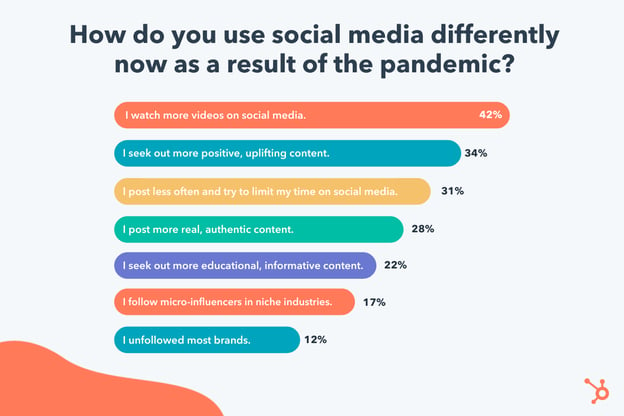
In particular, TikTok, the popular short-form video platform, saw exponential growth as a result of the pandemic. This can be attributed, in large part, to the authenticity of the content produced on TikTok.
As HubSpot's Senior Social Media Strategy Manager Leslie Green puts it, "A huge platform shift that happened during the pandemic was that tastemakers and culture shifters were born on TikTok — not Instagram. TikTok lifted the hyper-filtered veil off of social with short-form, intimate, and authentic video content."
Green adds, "TikTok, largely due to it's For You Page, became a place where anyone could be found. And in the last year many small creators blew up because they were able to create content that spoke poignantly to people's lived experiences and feelings."
If your business hasn't considered it already, 2022 is a good time to test out new types of short-form video content to see how it resonates with your audience.
Another increasingly popular option for video is live streaming.
Mari Smith, Premier Facebook Marketing Expert (often referred to as the 'Queen of Facebook') and Top Social Media Thought Leader, suggests brands lean more heavily into live streaming in 2022.
Smith says, "Embracing live streaming — whether Facebook, Instagram or LinkedIn Live — can go a long way towards creating more intimate relationships with your followers. Think of your live videos as 'mini webinars' and always strive to add nuggets of valuable, educational (and/or entertaining!) content, before adding your call-to-action."
In 2022, consider testing different platforms and content types — such as TikToks, Instagram Stories, YouTube videos, or Facebook live streams — to find out which video format performs best with your audience.
3. The pandemic impacted the best times to post on social.
Nowadays, many people work from home and have chosen remote work as their preferred lifestyle moving forward.
Suffice to say, the pandemic permanently shifted people's work schedules.
And, as the typical 9-to-5 work hours changed as a result of the pandemic, social media peak hours adjusted, too.
For instance, Sprout Social found the new best times to post on Facbook are Monday, Wednesday, and Friday from 10–11 a.m.; Monday, Tuesday and Friday at 11 a.m. and Tuesday at 2 p.m. are the best times to post on Instagram.
And currently, the best times to post on LinkedIn are Wednesday at 3 p.m, Thursday at 9–10 a.m., and Friday from 11 a.m.-noon.
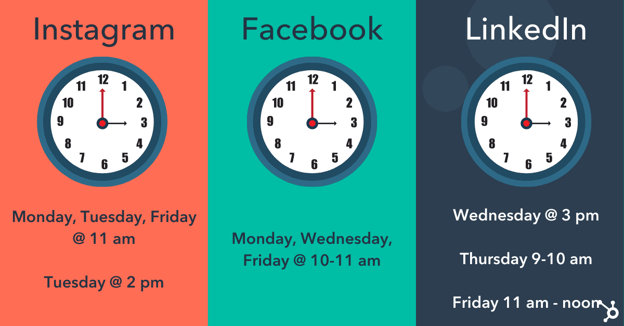
It's important to consider how the pandemic changed the way people work, and when. For instance, now that I'm working from home, I take a regular social media break every day around 10 a.m. while I eat my breakfast, since I don't have colleagues around to chat with.
In 2022, you'll want to conduct your own tests to determine which times are most popular with your audience — and on which channels.
4. The pandemic impacted the most popular types of content.
During the stress and uncertainty of quarantine and the beginning of the pandemic, many turned to social media to escape the real world. Which is why fun, lighthearted types of content won out.
In fact, in 2020, roughly half (42%) of Gen Zers said they wanted content described as fun — which surpassed Gen Zers' interest in romantic content (29%) and exciting content (27%).
As boredom as a result of quarantining ensued, social media consumers wanted bright, playful, light-hearted content to cheer them up.
Even now, two years later, 34% of HubSpot Blog Survey respondents said they still seek out more positive and uplifting content than they did pre-pandemic.
Along with more colorful, lighthearted content, we also saw an increase in authentic, user-generated content in 2020. Between March and April, during peak lockdown period, a Lightricks study found Americans spent over 90% more time using apps to create and edit images, videos, and visual content.
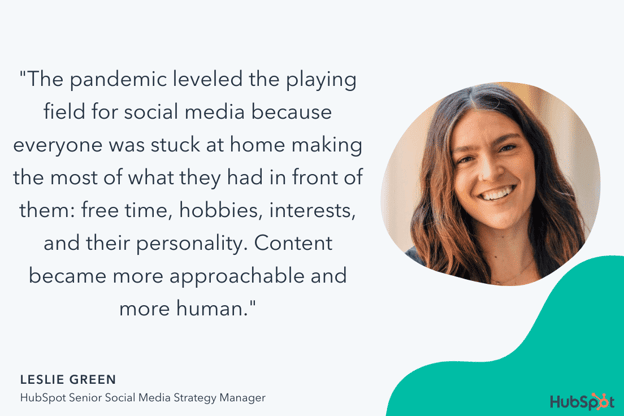
Green says, "The pandemic leveled the playing field for social media because everyone was stuck at home making the most of what they had in front of them: free time, hobbies, interests, and their personality. Content became more approachable and more human. Every day users created posts that spoke to real lived experiences rather than a curated image."
Neal Schaffer, Digital & Social Media Marketing Consultant, Speaker, and Author, agrees that the pandemic shifted the types of content that perform best.
He says, "One major impact that COVID had on social media was in keeping content real. When we couldn't go out for photo shoots, it required celebrities to turn their homes into studios and influencers to post more of their raw selves."
Schaffer says, "As human beings, we sought out people who were having similar experiences to us ... This made social media content more raw, believable, and authentic — and, as a result, further democratized content creation by lowering the threshold of what was required to create content."
Schaffer adds, "Combine this with the popularity of short-form video, and a whole new generation of content creators was born."
I'd argue we're all better off in a world in which social media users post authentic, non-filtered images to depict the realities of life. These #real posts help audiences feel less alone, and can foster a much stronger sense of community.
Which is why it's vital your team focuses on creating more authentic, behind-the-scenes content in 2022. In fact, many of you already plan to — HubSpot's Blog Research found 79% of B2B and 54% of B2C plan on increasing investments in authentic/behind the scenes content in 2022.
5. Quarantine sped up influencer marketing's popularity.
Influencer marketing grew exponentially as a result of the pandemic.
The influencer marketing industry went from $1.7 billion in 2016 to $9.7 billion in 2020 — a staggering 470% increase — and is expected to jump to $13.8 billion in 2021.
I spoke with Jesse Leimgruber, CEO of influencer marketing agency NeoReach, to learn his perspective on how the pandemic impacted the influencer marketing industry.
Leimgruber told me, "The pandemic boosted the creator economy into the spotlight. Millions of new creators joined the scene, and many found new ways to earn and support their craft. This extra attention on social media allowed influencers to earn money and turn a hobby into a profession."
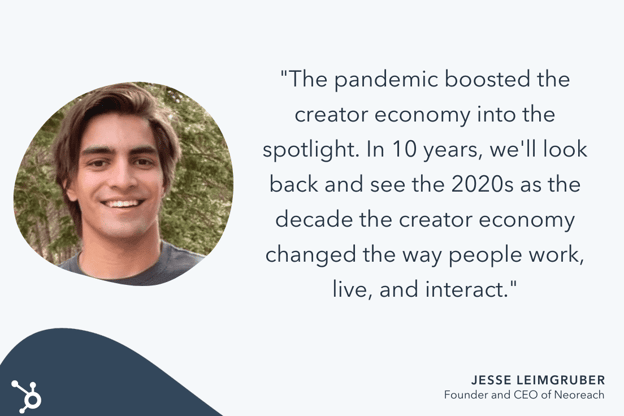
He adds, "Sponsored posts, partnerships, merch sales and fan donations have proliferated in the last two years. Venture dollars into the creator economy are at an all-time high, and public interest in the space is just getting started. In 10 years, we'll look back and see the 2020s as the decade the creator economy changed the way people work, live, and interact."
At the beginning of quarantine, we saw brands pull away from influencer marketing as the economy became more uncertain and volatile. This makes sense: As a relatively new form of marketing, influencer marketing can seem like a riskier investment to teams struggling to stay afloat.
However, as the world adjusted to lockdowns and remote work, influencer marketing began rising again in popularity. Influencer campaigns increased by 37% between Q2 and Q3 of 2020, and rose by an additional 34% between Q3 and Q4.
And influencer marketing's popularity isn't slowing down. In 2021, sponsored content increased by almost 27%.
Wayfair's Lala Fevrier agrees that the creator economy has skyrocketed — and, she adds, this creator economy is largely made up of Gen Z influencers.
Fevrier says, "The largest group to take advantage of social media's accessibility is Gen Z influencers. Because of their efforts, brands are starting to realize they don't need to spend millions of dollars producing content and ads that otherwise feel disingenuous at times. There is a network of individuals telling amazing stories about their favorite brands or products just because they love them."
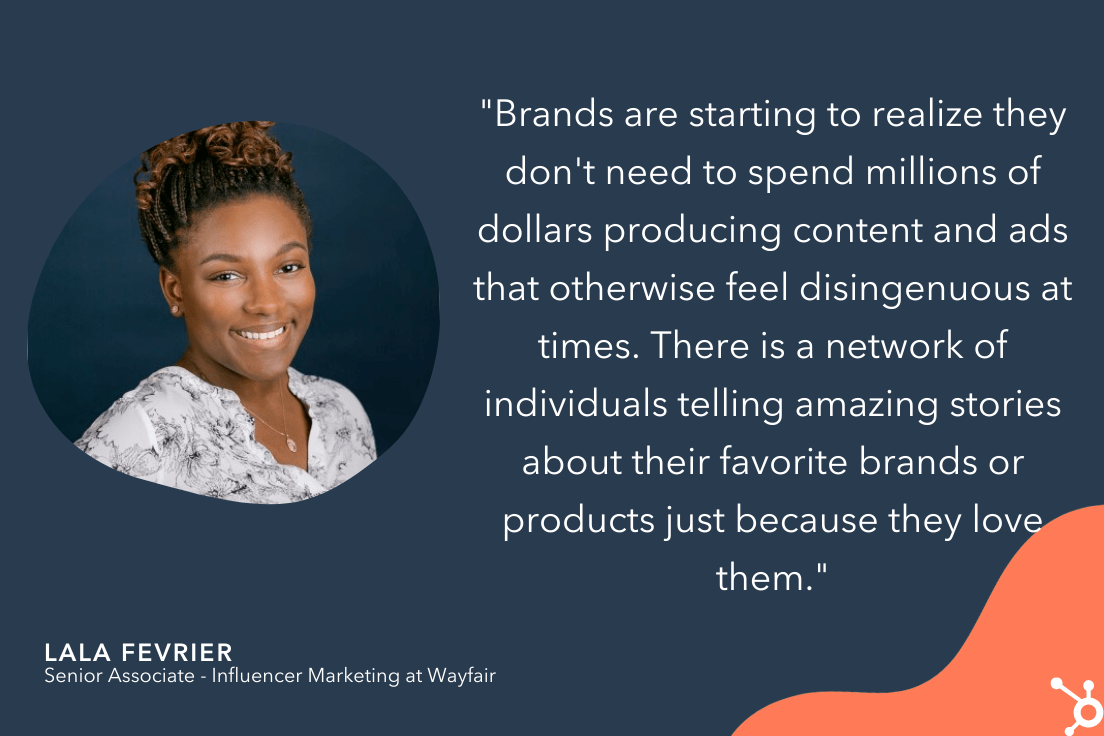
If you're interested in getting started with influencer marketing, consider the power of micro-influencers to engage directly with your intended audience and see more ROI than you might with a bigger celebrity. HubSpot's Blog Research surveyed marketers who already work with influencers, and found 67% of them work with micro-influencers (10K-100K followers/subscribers), followed by 58% who work with macro-influencers (100K-1M followers/subscribers).
6. The pandemic increased the need for community — and new platforms are rising, as a result.
Being stuck at home made it difficult — if not impossible — to feel a sense of community.
Pre-pandemic, many people turned to the office, fitness classes, parks, or other public spaces to feel connected to a larger group.
Overnight, those were no longer an option.
Fortunately, when used correctly, social media can fill in the gaps and help serve the fundamental human need of connection.
As Mari Smith told me: "You absolutely cannot beat the power of building a fiercely loyal community where members bond with one another — and with you."
Smith adds, "Certainly, [community] can be cultivated over time through a Facebook Group linked to your Facebook Page. However, community platforms are on the rise as users and leaders alike seek out different platforms on which to build and join tribes."
Smith says, "I surveyed my Facebook audience in October last year on this topic. Both Mighty Networks and Circle are growing in popularity in terms of an alternative to Facebook Groups. I predict we'll see a slight rise this year in community leaders choosing to migrate away from Facebook towards one of these other platforms in order to cater to their tribe members who've lost trust in Facebook."
Facebook Groups is still a viable option for creating a stronger sense of community and building relationships with your prospects and customers, but in 2022, you'll see brands experiment with other community-building platforms.
In 2021, social media became the #1 channel used in marketing. It's vital you learn how to pivot with these trends to continue to see growth and success across platforms.
The good news? Social media users are craving authenticity now more than ever. So the more your brand can lean into its own uniqueness, the better.
from Marketing https://blog.hubspot.com/marketing/quarantine-trends-social-media
At the beginning of the lockdown, many of us were unable to see family or friends. All social plans were cancelled — practically overnight.
And, in the midst of so much stress and chaos, many felt more alone than ever.
Which is why people turned to social media in an effort to find a sense of connection and community.
Social media became a refuge — a place to post authentic, relatable content and form relationships virtually when in-person wasn't an option.
And as Lala Fevrier, Wayfair's Senior Associate for Influencer Marketing, puts it, "When restaurants, schools, and businesses shut down, the only place left with a 24/7 open sign for communication and creativity was social media."
All of which is to say: Quarantine, and the pandemic at-large, greatly impacted social media. And those changes have permanently shifted users' expectations and preferences when it comes to their social platforms.
Here, we'll explore six trends we've seen as a result of the pandemic — and why they're here to stay.
How The Pandemic Changed Social Media
1. Quarantine increased time spent on social media, as well as social users worldwide.
Between 2019 to 2021, the amount of social media users worldwide increased by 11% — from roughly 3.4 billion in 2019 to 3.78 billion in 2021.
As lockdown orders went into effect, many sought out new opportunities to connect with friends and family. In fact, we saw a 5% jump in global users from 2019 to 2020 alone.
People were also bored, which significantly increased the time spent on social media apps. Consider, for instance, the sudden popularity of bread baking in March, or the random challenges across social apps, like the "flip the switch" challenge that exploded on TikTok in 2020:
I know this boredom first-hand: During the beginning of the pandemic, I spent roughly 4 hours each day on Instagram. Rather than grabbing dinner with friends after work or chatting with colleagues on my lunch break, I scrolled through people's IG Stories.
I'm not alone. In the U.S., social media users jumped from spending 56 minutes per day on social media in 2019 to 65 minutes in 2020 and 2021. And, globally, people spent 145 minutes per day on social media in 2020. (It's important to note: That number has decreased to 142 minutes per day in 2021, suggesting a slight decline in social media use as some of the world re-opens.)
Social media became a place to escape the turmoil of the real world. Along with a spike in social media users, engagement increased on certain platforms, as well. On Instagram, for instance, the average engagement rate for brands increased by roughly 6% in 2020.
For Sarah White (@thecoastalyogi), a Boston-based fitness instructor and influencer, the pandemic was a catalyst for her to launch virtual offerings and leverage social media as an opportunity to create a strong sense of community.
White told me, "Virtual offerings were a side of my business I had considered, but had never seen a need for until March of 2020. Since then, my virtual subscriptions have become a major part of my business and are the primary way I interact with my clients."
White adds, "My Instagram is my primary source of marketing so my posting has definitely increased. I am intentional about answering every message I receive from clients as I know it's this type of relationship-building that differentiates a following from a community."
2. Quarantine impacted video consumption.
2020 was an impressive year for video. In fact, media uploads increased by a staggering 80% year-over-year — peaking at 103,603 video uploads on April 22.
The minutes people spent watching videos in 2020 also increased by 85%.
The pandemic greatly impacted how quickly video rose in popularity. It's now the most popular type of content, and has been for two years in a row.
Additionally, in a HubSpot Blog survey, 42% of respondents said "I watch more videos on social media" in response to the question, "How do you use social media differently now as a result of the pandemic?"

In particular, TikTok, the popular short-form video platform, saw exponential growth as a result of the pandemic. This can be attributed, in large part, to the authenticity of the content produced on TikTok.
As HubSpot's Senior Social Media Strategy Manager Leslie Green puts it, "A huge platform shift that happened during the pandemic was that tastemakers and culture shifters were born on TikTok — not Instagram. TikTok lifted the hyper-filtered veil off of social with short-form, intimate, and authentic video content."
Green adds, "TikTok, largely due to it's For You Page, became a place where anyone could be found. And in the last year many small creators blew up because they were able to create content that spoke poignantly to people's lived experiences and feelings."
If your business hasn't considered it already, 2022 is a good time to test out new types of short-form video content to see how it resonates with your audience.
Another increasingly popular option for video is live streaming.
Mari Smith, Premier Facebook Marketing Expert (often referred to as the 'Queen of Facebook') and Top Social Media Thought Leader, suggests brands lean more heavily into live streaming in 2022.
Smith says, "Embracing live streaming — whether Facebook, Instagram or LinkedIn Live — can go a long way towards creating more intimate relationships with your followers. Think of your live videos as 'mini webinars' and always strive to add nuggets of valuable, educational (and/or entertaining!) content, before adding your call-to-action."
In 2022, consider testing different platforms and content types — such as TikToks, Instagram Stories, YouTube videos, or Facebook live streams — to find out which video format performs best with your audience.
3. The pandemic impacted the best times to post on social.
Nowadays, many people work from home and have chosen remote work as their preferred lifestyle moving forward.
Suffice to say, the pandemic permanently shifted people's work schedules.
And, as the typical 9-to-5 work hours changed as a result of the pandemic, social media peak hours adjusted, too.
For instance, Sprout Social found the new best times to post on Facbook are Monday, Wednesday, and Friday from 10–11 a.m.; Monday, Tuesday and Friday at 11 a.m. and Tuesday at 2 p.m. are the best times to post on Instagram.
And currently, the best times to post on LinkedIn are Wednesday at 3 p.m, Thursday at 9–10 a.m., and Friday from 11 a.m.-noon.

It's important to consider how the pandemic changed the way people work, and when. For instance, now that I'm working from home, I take a regular social media break every day around 10 a.m. while I eat my breakfast, since I don't have colleagues around to chat with.
In 2022, you'll want to conduct your own tests to determine which times are most popular with your audience — and on which channels.
4. The pandemic impacted the most popular types of content.
During the stress and uncertainty of quarantine and the beginning of the pandemic, many turned to social media to escape the real world. Which is why fun, lighthearted types of content won out.
In fact, in 2020, roughly half (42%) of Gen Zers said they wanted content described as fun — which surpassed Gen Zers' interest in romantic content (29%) and exciting content (27%).
As boredom as a result of quarantining ensued, social media consumers wanted bright, playful, light-hearted content to cheer them up.
Even now, two years later, 34% of HubSpot Blog Survey respondents said they still seek out more positive and uplifting content than they did pre-pandemic.
Along with more colorful, lighthearted content, we also saw an increase in authentic, user-generated content in 2020. Between March and April, during peak lockdown period, a Lightricks study found Americans spent over 90% more time using apps to create and edit images, videos, and visual content.

Green says, "The pandemic leveled the playing field for social media because everyone was stuck at home making the most of what they had in front of them: free time, hobbies, interests, and their personality. Content became more approachable and more human. Every day users created posts that spoke to real lived experiences rather than a curated image."
Neal Schaffer, Digital & Social Media Marketing Consultant, Speaker, and Author, agrees that the pandemic shifted the types of content that perform best.
He says, "One major impact that COVID had on social media was in keeping content real. When we couldn't go out for photo shoots, it required celebrities to turn their homes into studios and influencers to post more of their raw selves."
Schaffer says, "As human beings, we sought out people who were having similar experiences to us ... This made social media content more raw, believable, and authentic — and, as a result, further democratized content creation by lowering the threshold of what was required to create content."
Schaffer adds, "Combine this with the popularity of short-form video, and a whole new generation of content creators was born."
I'd argue we're all better off in a world in which social media users post authentic, non-filtered images to depict the realities of life. These #real posts help audiences feel less alone, and can foster a much stronger sense of community.
Which is why it's vital your team focuses on creating more authentic, behind-the-scenes content in 2022. In fact, many of you already plan to — HubSpot's Blog Research found 79% of B2B and 54% of B2C plan on increasing investments in authentic/behind the scenes content in 2022.
5. Quarantine sped up influencer marketing's popularity.
Influencer marketing grew exponentially as a result of the pandemic.
The influencer marketing industry went from $1.7 billion in 2016 to $9.7 billion in 2020 — a staggering 470% increase — and is expected to jump to $13.8 billion in 2021.
I spoke with Jesse Leimgruber, CEO of influencer marketing agency NeoReach, to learn his perspective on how the pandemic impacted the influencer marketing industry.
Leimgruber told me, "The pandemic boosted the creator economy into the spotlight. Millions of new creators joined the scene, and many found new ways to earn and support their craft. This extra attention on social media allowed influencers to earn money and turn a hobby into a profession."

He adds, "Sponsored posts, partnerships, merch sales and fan donations have proliferated in the last two years. Venture dollars into the creator economy are at an all-time high, and public interest in the space is just getting started. In 10 years, we'll look back and see the 2020s as the decade the creator economy changed the way people work, live, and interact."
At the beginning of quarantine, we saw brands pull away from influencer marketing as the economy became more uncertain and volatile. This makes sense: As a relatively new form of marketing, influencer marketing can seem like a riskier investment to teams struggling to stay afloat.
However, as the world adjusted to lockdowns and remote work, influencer marketing began rising again in popularity. Influencer campaigns increased by 37% between Q2 and Q3 of 2020, and rose by an additional 34% between Q3 and Q4.
And influencer marketing's popularity isn't slowing down. In 2021, sponsored content increased by almost 27%.
Wayfair's Lala Fevrier agrees that the creator economy has skyrocketed — and, she adds, this creator economy is largely made up of Gen Z influencers.
Fevrier says, "The largest group to take advantage of social media's accessibility is Gen Z influencers. Because of their efforts, brands are starting to realize they don't need to spend millions of dollars producing content and ads that otherwise feel disingenuous at times. There is a network of individuals telling amazing stories about their favorite brands or products just because they love them."

If you're interested in getting started with influencer marketing, consider the power of micro-influencers to engage directly with your intended audience and see more ROI than you might with a bigger celebrity. HubSpot's Blog Research surveyed marketers who already work with influencers, and found 67% of them work with micro-influencers (10K-100K followers/subscribers), followed by 58% who work with macro-influencers (100K-1M followers/subscribers).
6. The pandemic increased the need for community — and new platforms are rising, as a result.
Being stuck at home made it difficult — if not impossible — to feel a sense of community.
Pre-pandemic, many people turned to the office, fitness classes, parks, or other public spaces to feel connected to a larger group.
Overnight, those were no longer an option.
Fortunately, when used correctly, social media can fill in the gaps and help serve the fundamental human need of connection.
As Mari Smith told me: "You absolutely cannot beat the power of building a fiercely loyal community where members bond with one another — and with you."
Smith adds, "Certainly, [community] can be cultivated over time through a Facebook Group linked to your Facebook Page. However, community platforms are on the rise as users and leaders alike seek out different platforms on which to build and join tribes."
Smith says, "I surveyed my Facebook audience in October last year on this topic. Both Mighty Networks and Circle are growing in popularity in terms of an alternative to Facebook Groups. I predict we'll see a slight rise this year in community leaders choosing to migrate away from Facebook towards one of these other platforms in order to cater to their tribe members who've lost trust in Facebook."
Facebook Groups is still a viable option for creating a stronger sense of community and building relationships with your prospects and customers, but in 2022, you'll see brands experiment with other community-building platforms.
In 2021, social media became the #1 channel used in marketing. It's vital you learn how to pivot with these trends to continue to see growth and success across platforms.
The good news? Social media users are craving authenticity now more than ever. So the more your brand can lean into its own uniqueness, the better.
![Download Now: Social Media Trends in 2022 [Free Report]](https://no-cache.hubspot.com/cta/default/53/3dc1dfd9-2cb4-4498-8c57-19dbb5671820.png)

No hay comentarios:
Publicar un comentario